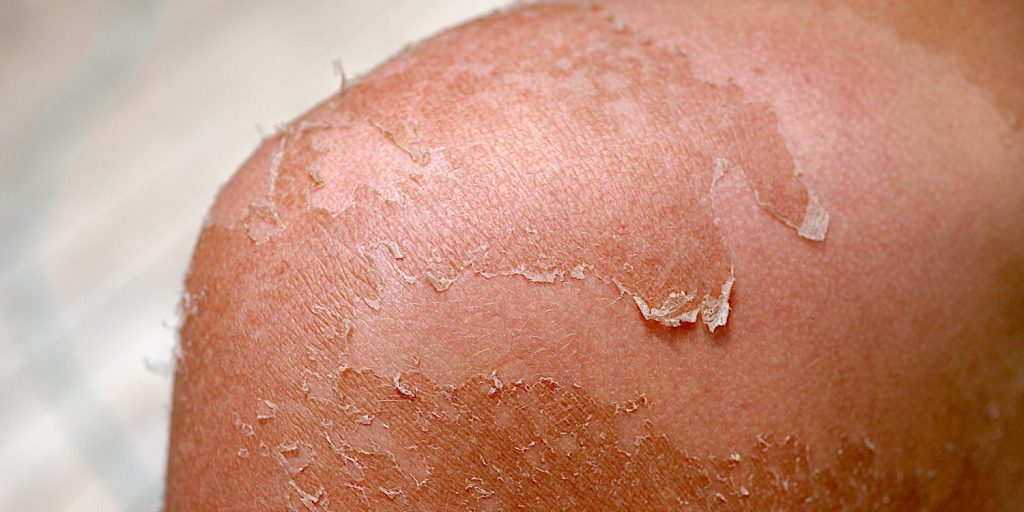
Philippe Lissac /GODONG/Getty Images
- Most sunburn will last for three to five days, but severe burns can take weeks or months to heal.
- You can't speed up the sunburn healing process, but moisturizing the skin can provide relief.
- To prevent future sunburns, apply sunscreen, seek shade, and wear long-sleeves when in the sun.
- Visit Insider's Health Reference library for more advice.
More than 1 out of every 3 Americans report getting sunburned at least once a year. A sunburn is your skin's reaction to becoming damaged by the sun's ultraviolet (UV) radiation and results in redness and pain. Because of this, many people wonder how quickly the pain or unsightly redness will disappear.
Here's how long a sunburn lasts and how to ease the symptoms as it heals.
How long does sunburn last?
Most sunburns are considered mild and typically last about three to five days, though this can vary depending on the severity of the burn:
3 to 5 days for a first-degree or mild burn
With a first-degree burn, the top layer of the skin, known as the epidermis, is injured, resulting in redness and soreness. A first-degree burn will be sensitive to the touch and may peel as it heals, but is unlikely to result in blistering or scarring, says Annie Gonzalez, MD, a dermatologist with Riverchase Dermatology.
2 to 3 weeks for a second-degree or moderate burn
Damage from a second-degree burn reaches both the first and second layers of the skin, causing extreme redness that is usually a deeper shade than a first-degree burn. This type of burn can also result in blisters and scarring and take two to three weeks to heal.
Months for a third-degree or severe burn
A third-degree burn from the sun is rare, but can happen, Gonzalez says. This type of burn affects all three layers of the skin - the epidermis, dermis, and fat, resulting in a purplish discoloration of the skin, extreme blistering, and sometimes a mild fever. A third-degree burn requires immediate medical attention, Gonzalez says, and can take months to heal.
How long does peeling from sunburn last?
In addition to pain and redness, peeling from sunburn can also be unsightly and itchy. Peeling usually starts about three days after you burn and can last for several days. Whether or not your sunburn peels depends on the depth and intensity of the damage and your skin type. Peeling is common with first and second-degree sunburns, but not necessarily a guarantee. The lighter your skin tone, the more likely you are to peel, Gonzalez says.
How to get rid of sunburn
Unfortunately, once you get a sunburn, there is no way to speed up the healing process, but you can treat the symptoms.
Here are some ways to treat a first-degree sunburn:
- Soak in a cool bath or take a cool shower.
- Gently rub fragrance-free aloe vera gel or moisturizer on your burn.
- Take an over-the-counter pain reliever like ibuprofen or aspirin.
- Drink lots of water.
- Apply a small amount of 1% hydrocortisone cream to your sunburn three to four times a day.
- Stay out of the sun and wear loose, protective clothing over your burn if you do have to be outside. Do not expose your burn to more UV radiation until it is completely healed, Gonzalez says.
In most cases, a second-degree burn can also be treated at home using many of the same methods, Gonzalez says.
If your first or second-degree does not improve after two weeks, consult with a doctor. A third-degree sunburn requires immediate medical attention and should not be treated at home.
How to prevent sunburn
Sunburns can increase your risk of developing skin cancer, so preventing them not only helps you avoid discomfort but also protects your overall health, says Beth Goldstein, MD, a dermatologist with Central Dermatology Center.
Ultraviolet (UV) radiation is the leading cause of melanoma, the most deadly kind of skin cancer, resulting in about 9,000 deaths in the US each year. Getting five or more sunburns in your life more than doubles your risk of developing melanoma.
In fact, a large 2014 study examining the effects of sun exposure in white women found those who experienced five or more blistering sunburns between the ages of 15 and 20 had an 80% increased risk for melanoma and a 68% increased risk for nonmelanoma skin cancers.
Therefore, it's important to take steps to protect your skin, such as:
- Wear a broad-spectrum sunscreen with SPF 30 or higher when you go outside, even if it's cloudy. Wearing sunscreen has been shown to reduce your risk of skin cancer.
- Wear protective clothing when you go outdoors, like a wide-brimmed hat, sunglasses or long sleeves and pants. Try to wear clothes with an ultraviolet protection factor (UPF) that help block out ultraviolet rays.
- Avoid the sun. Seek shade or stay inside between 10 a.m. and 3 p.m. when the sun is strongest.
- Apply sunscreen 15 to 30 minutes before going outside to allow the sunscreen to sink into your skin. If you are spending several hours outside, reapply every two hours.
Insider's takeaway
A sunburn is your skin's inflammatory reaction to UV damage, which can result in pain, redness, peeling, and blisters. How long your sunburn lasts depends on your skin type and the severity of the burn, but in general, most mild burns heal in three to five days.
If your sunburn does not improve in two weeks, or if you experience signs of a third-degree burn, like purple discoloration and a mild fever, seek medical attention. Your doctor can assess your burn and prescribe antibiotics or creams that can help.
